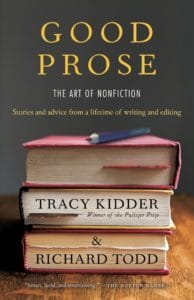What happens when you begin reading a book or an essay or a magazine story? If the writing is at all interesting, you are in search of the author. You are imagining the mind behind the prose. Often that imagining takes a direct, even visceral form: who is this person?
—Richard Todd
Good Prose: The Art of Nonfiction
Most editors would agree that we learn as much from the writers we work with as they learn from us. That’s certainly the case for me. Each client and each book or article is a chance to explore a new topic, to learn some of the backstory behind the writer’s choice of subject, and to tackle a new set of challenges in the structure, voice, and theme of a manuscript. But every project begins with the same question—sometimes unspoken, but always urgent—from editor to writer: Who are you?
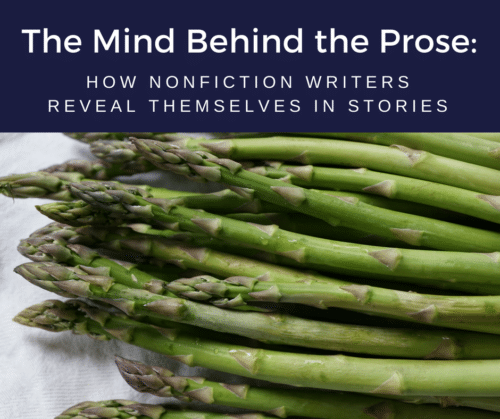
Shawn and Tim get at this question again in the podcast episode, “Tell Your Story,” as Shawn explains to Tim that focusing on his audience (entrepreneurs? writers? all creatives?) isn’t the key to his Big Idea book; the key is focusing on his own story. We’ve learned from Shawn’s dissection of Tim’s and Malcolm Gladwell’s work that the author-protagonist’s journey is the heart of the Big Idea book. But lately I’ve been thinking about the other nonfiction genres, and I now believe that if you’re working on a how-to, an academic, or a narrative nonfiction piece like a memoir, the first question readers want you to answer is still the same: Who are you?
It’s pretty self-evident that narrative nonfiction is driven by story. Journalists and historians may or may not reveal their own personal stories overtly, but they often include introductions or acknowledgments that tell readers something important about their personal connections to the tales they’re telling. And all these writers reveal something of themselves in the choice of the subjects they spend years—sometimes decades—of their lives investigating. Look at the lists of titles under the names Bob Woodward, Jon Krakauer, Mary Roach, David McCullough, or Doris Kearns Goodwin, and see if you can figure out something about who they are.
Today, I want to take a quick look at how a narrative nonfiction author reveals herself through a simple story and then move on to examples from a how-to book and a quasi-academic nonfiction book. The subject under discussion in all three cases is appropriate as we leap into spring: asparagus. I’m going with the topic of asparagus because I was inspired to write this post by an artful story about writer Elizabeth Gilbert’s transformation via some particularly tender and meaningful green spears.
Packaged like pencils
In red, green or white
Put asparagus spears
On your menu tonight
—Judith Natelli McLaughlin
Poems on Fruits & Odes to Veggies
Memoir:
Turning Up the Who-You-Are Story to 11
A few weeks ago, two of my clients taught me an important lesson in not judging a book by its pop culture reputation. In separate phone calls just a few days apart, they both told me they had found inspiration of different sorts in Elizabeth Gilbert’s massively popular memoir, Eat, Pray, Love. I had to admit that I hadn’t read it. What I didn’t admit was that I thought I knew all I needed to know about the book based on pop culture parodies and the snippets of Gilbert and her movie avatar, Julia Roberts, I’d seen on YouTube. My cynical soul resisted the idea of a beautiful, rich, WASPy woman living it up, self-actualizing her way across the globe, and then falling in love with Prince Charming in Paradise. Give me a break.
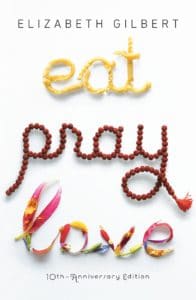
Well, it’s a well-written book, for starters; not only in terms of its overall structure, but also in terms of sentence- and paragraph-level writing. At various points, it’s heartbreaking, suspenseful, and full of surprising observations. Gilbert is often funny and self-deprecating. I wasn’t expecting to laugh with her so much.
Her use of simple stories to tell truths about herself and the cultures in which she lived hit me in Chapter 21. If you’ve read the book or seen the movie, you remember this part. Liz spends several pages setting up the scene with detailed backstory about her Yankee farmer upbringing and her inability, as a work-obsessed American, to really enjoy life and experience pleasure for its own sake. She contrasts that with the everyday pleasures of Italy and laments her own failings and anxieties. The heart of the scene is a short story about one lunch. The story couldn’t possibly be simpler, and that was a lesson I want to remember: When in doubt, pare things down to their simplest form. She has already told us that all she wants is to truly enjoy the food and language of Italy. Then the heart of the scene begins.
In the inciting incident, Liz finds a new food market near her apartment in Rome. Her progressive complications are in fact, progressive pleasures: She buys fresh asparagus. In buying the asparagus, she is able to have a full conversation in Italian with the mother and son operating the vegetable stand, including a little joke. Liz goes home to prepare lunch, and finds pleasure in making it beautiful:
I walked home to my apartment and soft-boiled a pair of fresh brown eggs for my lunch. I peeled the eggs and arranged them on a plate beside the seven stalks of the asparagus (which were so slim and snappy they didn’t need to be cooked at all). I put some olives on the plate, too, and the four knobs of goat cheese I’d picked up yesterday from the formaggeria down the street, and two slices of pink, oily salmon. For dessert— a lovely peach, which the woman at the market had given to me for free and which was still warm from the Roman sunlight. For the longest time I couldn’t even touch this food because it was such a masterpiece of lunch, a true expression of the art of making something out of nothing. Finally, when I had fully absorbed the prettiness of my meal, I went and sat in a patch of sunbeam on my clean wooden floor and ate every bite of it, with my fingers, while reading my daily newspaper article in Italian. Happiness inhabited my every molecule.
—Elizabeth Gilbert
Eat, Pray, Love, Chapter 21
Liz eats her beautiful lunch and reads the newspaper in Italian—a moment we appreciate because of the previous dozen chapters in which we’ve seen her studying and struggling with the language. She meets her crisis in the form of her ex-husband’s voice in her head, as he (of course, it’s really her own voice) tries to make her feel guilty. Will she give in to the guilt she was born and bred to feel or not? Will she fail again in her quest to become her own peculiar version of Italian? In the climax she tells her husband’s voice to shut up and keeps reading and eating. Her transformation, at least for the moment, succeeds. The chapter began in Puritan guilt and despair and ends in utter happiness. Now that’s a value shift.
The one-sentence summary of this chapter is Liz makes a tasty lunch. But in telling this story so fully, with layers of detail and memories of two cultures—the American and the Italian—she brings the whole first quarter of the book together in a memorable way that tells us what we need to know about where she’s been and where she wants to go.
The How-To of How-To Author Stories:
Short, Sweet, and Spicy
I’m working with a client on a how-to book right now, and we’ve just realized how much better the book could be with the addition of a few well-placed stories to enliven the parade of information, information, information, marching forward chapter after chapter. We might even want to make the reader laugh occasionally, as Gilbert does, while dispensing all that information.
Stories that offer peeks into the author’s life or work that are pertinent to the book’s message as a whole are what separate great how-to books from encyclopedias. You won’t find me knocking reference books—they’re incredibly valuable tools, and I have a shelf of them close at hand—but if you want readers to open your how-to book with even a tiny measure of excitement and anticipation, instead of leaving it on the shelf until they really need to find out how to build a cabinet or a compost heap—then a few stories about yourself are essential.
I’m not a woodworker or a gardener, so the most common how-to books in my house are cookbooks. To test my idea, I pulled out one by my food TV heroine, Nigella Lawson. She introduces a recipe for a supper of asparagus tips and sweet potatoes like this:
This is one of those creations that came into being simply because, while trolling around the supermarket one evening, I was overwhelmed with desire for sweet potatoes and then lured by some asparagus tips, only to come home to find a packet of lardons, that French cubed bacon, winking at me from the fridge. It had to be. I’ve now made it quite a few times, on those evenings when I’m too tired to be paying an awful lot of attention—or busy with other duties—and yet not in any particular hurry to eat (as I so often am) five minutes ago.
—Nigella Lawson
Nigella Kitchen: Recipes from the Heart of the Home
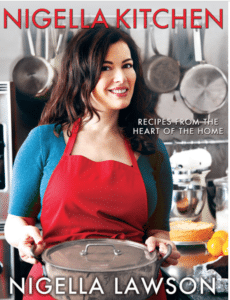
But the other face of Nigella is a flirty domestic goddess, an expert in all things delicious and decadent. So in the excerpt above, she plays up the romance of the kitchen: she feels a sudden desire for potatoes, the asparagus lures her shamelessly with its tips, and oh that naughty winking French bacon. I’m sweating just thinking about it.
Nigella keeps her readers by demonstrating her expertise in the real how-to portion of each recipe, but she seduces us with little stories that show us a glimpse of who she is and the promise of much more fun in the kitchen than most of us have ever experienced.
Let’s Get Academic.
But First, How About Some Dinner?
I’m off-and-on working on editing a Big Idea book that leans strongly toward the academic because it’s built on mounds and mounds of evidence in a dissertation. In its current form it’s an ugly beast. I hate it. It’s my own writing, not a client’s. I know that if I want more than three people to read it, I need to thread some good stories that reveal a little about my point of view in there amidst all the quotes and footnotes.
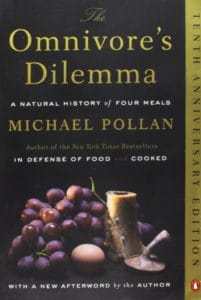
In Chapter 5 of Omnivore, ominously titled “My Organic Industrial Meal,” Pollan examines the food chain that brings organic asparagus grown in Argentina to his Sunday dinner table in Berkeley, California. The chapter itself is jam-packed with details about energy consumption in the food industry, labor practices, animal welfare, the chemistry of polyphenols and how the plastic bags of some organic food companies allow for proper respiration of their spring mix greens, the history of nutritional science, USDA politics . . . well, you get the idea. It’s a lot of information. But all the information is wrapped around a simple story about Pollan making Sunday dinner for his family. He lets us know what he chose for dinner and how each item turned out, from the roast chicken to a dessert of ice cream and blackberries. When he gets to the vegetables, he disparages the pricey organic asparagus he bought at Whole Foods:
My jet-setting Argentine asparagus tasted like damp cardboard. After the first spear or two no one touched it. Perhaps if it had been sweeter and tenderer we would have finished it, but I suspect the fact that asparagus was out of place in a winter supper made it even less appetizing.
—Michael Pollan
The Omnivore’s Dilemma, Chapter 5
Pollan’s insult of the asparagus turned into a public kerfuffle when Whole Foods CEO John Mackey wrote an open letter disagreeing with some of the book’s arguments about the “organic industrial” food system and sent Pollan a $25 gift card to make up for the tragic asparagus experience.
The point I want to make here—in addition to praising Pollan’s genius in combining such a simple personal story with extremely complex evidence from science, economics, and politics—is that the story of the cardboard asparagus is one of the things that readers, and the Whole Foods CEO, remember most vividly from this chapter. The image of the Pollan family trying to swallow the tasteless spears is what helps us make sense of and process the rest of the information. Months or years after we read Omnivore, we won’t remember exactly what Pollan explained about organic vs. traditionally farmed carrots, but we’ll remember his Sunday dinner and attach to that story a few facts about what industrial organic farming is—and its pros and cons—so that it remains meaningful long after we’ve closed the book.
Throughout Omnivore’s Dilemma, when it really helps readers understand his larger argument, Pollan tells stories about Pollan—as a cook, a gardener, a parent, and an eater. He answers the editor’s and the reader’s first question: Who are you?
A Little Help in Answering the Question
My purpose in looking at these three sorts of stories is not just to make you hungry. What I want to do is remind you not to be afraid of telling the story of who you are in your nonfiction, whether it’s a how-to, academic, narrative, or Big Idea book. Tailor the stories—their length, depth, and lightness or darkness—to the purpose of the book. (A book about baking isn’t the place for a story about Nigella’s difficult divorce.) If you don’t want your nonfiction to gather dust on the shelf, telling readers who you are is essential. And if you’re having trouble, a good editor might be able to help you figure out how to capture who you are in a simple story or two . . . or in the case of a memoir, twenty or thirty.
Recently, Story Grid editor Courtney Harrell wrote a wonderful article about “Finding Your Theme in the Story of You” that’s helpful if you’re trying to figure out how your own life intersects with themes in your creative work. Listen to Courtney when she says, “In order for our stories to resonate with others, they have to get personal.” Another way to investigate the overlap between your own life and the story you want to tell is to examine core emotions. This is when you want editors Anne Hawley and Leslie Watts to take you by the hand and show you how to “Discover Your Story’s Core,” And if you’ve been listening to the podcast lately, you know that the intensive course Tim’s been getting on writing the truth, and nothing but the truth, of his own Big Idea book, is a perfect primer on this topic. I’ve listened to these episodes several times already, and am so glad we have the transcripts available. In order, those recent episodes (115, 116, and 117) on Big Idea nonfiction are: “Finding My Why ,” “Truth vs. Truth,” and “Tell Your Story.”
As Tim and Shawn keep adding episodes to their library of podcasts on nonfiction, I’ll keep updating the list of nonfiction resources on the Story Grid website as quickly as I can.
A final note:
